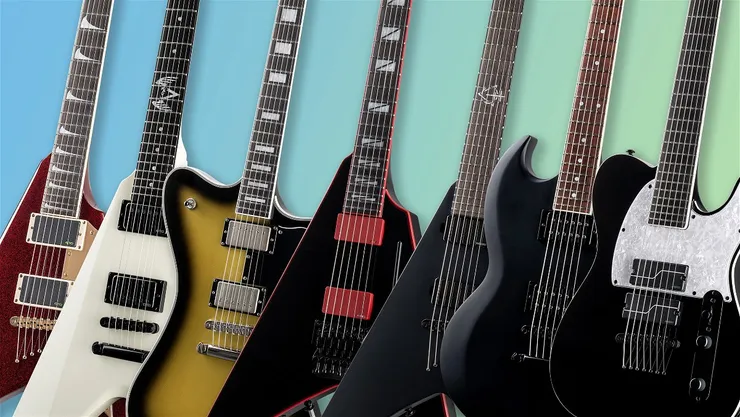Characteristics of Guitar in Metal Music
To the uninitiated, metal music may just sound like a lot of noise, but nothing could be further from the truth. Unlike any other genre, metal plays host to an endless list of subgenres. But whether it’s the downtuned brutality of death metal, the polyrhythms of djent, or the melodic intricacies of power metal, a strong guitar sound is usually at the heart of everything.
In terms of guitar playing itself, this also varies just as much as metal subgenres. On the one hand, you have pummelling and precise rhythmic chugging, with standout performers including James Hetfield, Paul Landers, and Adam Jones. On the other hand, there’s the soaring lead guitar prowess of axe masters such as Jeff Loomis, Alex Skolnick, Dimebag Darrell, and Eddie Van Halen. And that’s before you even consider the unique visionaries who consistently rewrite the rulebook on guitar playing - the likes of John Petrucci, Tosin Abasi, Devin Townsend, and John 5.
Metal guitar possesses a brutal power intertwined with delicate nuances. It exudes absolute control while teetering on the edge of chaos. Without it, the essence of metal would be lost.
Humbucker Pickups, but Not -Any- Humbuckers
When considering the best pickups for metal, the choice often boils down to which are the best humbuckers! Their ability to reduce noise and interference is essential in metal, as is their tendency to produce a cleaner, heavier sound.
Active pickups are a favourite in the metal community for their high output and tight, compressed sound signature. They enable precise note articulation even in highly saturated, gain-driven settings, making them ideal for the complex riffs and solos that define much of metal music.
On the other hand, passive pickups offer excellent dynamic range and warmth for a more organic sound. With richer harmonic overtones, they’re suitable for creating depth and dimension in your music.
Brands like EMG, Seymour Duncan, Fishman, and DiMarzio are at the forefront of metal pickups, offering models specifically engineered to cater to the nuanced demands of the genre’s guitarists. EMG’s 81/85 combination, for instance, has become almost synonymous with the genre, celebrated for its aggressive tone and excellent clarity in low tunings. Seymour Duncan’s Blackouts and DiMarzio’s D Activator pickups are also popular choices for their powerful output and fidelity, ensuring that every palm-muted chug and sweeping solo cuts through the mix with ferocity.
Ultimately, the selection of pickups is a personal choice. As much as the guitar itself, they can reflect a guitarist’s desired tonal characteristics and style of play.
Scale Length and Downtuning
Downtuning is the act of tuning your guitar to an alternate tuning that’s lower than standard tuning, and it’s a VERY important part of modern metal. As the genre evolves, bands consistently aim for new levels of heaviness, and tunings keep getting lower. While drop D is still a popular option, today’s metal bands frequently explore tunings as low as B, A, or even drop E - a full octave lower than standard tuning.
When downtuning (and in the absence of extended range guitars, more on that later), scale length plays a pivotal role in achieving the desired sound while still keeping the guitar playable. In essence, scale length is the distance between the guitar’s nut and bridge, influencing tension and tone.
Longer scale lengths, such as those found on baritone guitars, provide increased tension at lower tunings, allowing for tighter string response and preventing unwanted floppiness. This is especially beneficial for playing fast, articulate passages, as it enhances the clarity and definition of each note.
Conversely, shorter scale lengths offer a slinkier feel, which some players may prefer for bends and vibrato. Low tunings might be out of the question, but shorter scale lengths allow for the use of lighter string gauges. Not only are such strings brighter and more responsive, but they also require less force and are, therefore, easier to play.
Brands like Ibanez, Schecter, and ESP all sell models that cater specifically to metal players, offering guitars with extended scale lengths ideal for downtuning. Whether engaging in the doom-laden riffs of stoner metal or the intricate shredding of technical death metal, the right combination of scale length and tuning can profoundly affect a guitarist’s ability to execute their vision with precision and power.
Extended Range Guitars and Metal Music
Extended range guitars, which include 7-string, 8-string, and even 9-string guitars, take scale length up a notch. These instruments have had a significant impact on metal music, offering an expansive sonic palette that appeals to metal guitarists seeking to push the boundaries of heavy, atmospheric sounds.
The additional lower strings allow for deeper, more resonant tuning, which can produce the signature chugging riffs and atmospheric textures synonymous with many metal subgenres, from djent to progressive metal. This extended range also facilitates complex chord structures and intricate melodies that would be difficult to achieve on traditional 6-string guitars.
These guitars have led to an evolution of playing techniques, with musicians employing extended range-specific methods such as thumping and tapping to fully exploit the instruments’ capabilities. By broadening the harmonic and melodic possibilities of metal guitar playing, these instruments have helped the genre to continually innovate and evolve.
The Importance of Guitar Necks in Metal Music
The construction and design of guitar necks also play a pivotal role in defining a metal guitar’s tonal characteristics and playability. Neck material and construction methods, such as set-in, bolt-on, and neck-through, significantly influence sustain and resonance. For example, neck-through guitars typically offer enhanced sustain and stability, allowing guitarists to hold long, sustaining notes amidst high-gain settings.
The profile and thickness of the neck will also affect playability and comfort. A guitarist who performs complex riffs and solos might, for instance, opt for a shallow C-shape neck, whereas a rhythm guitarist with large hands might prefer the feel of a U-shape neck.
Acoustic Guitars and Metal?!
Traditionally, metal is synonymous with electrifying riffs, aggressive distortions, and a robust rhythm section. You might think that hardly leaves room for the nuanced, warmer tones of an acoustic guitar. However, this juxtaposition can inject a fresh dynamic into the metal soundscape.
Acoustic guitars can offer a dynamic counterbalance to metal’s intrinsic intensity, creating atmospheric interludes, intros, or even entire compositions that stand out for their raw, unplugged sincerity. This blend showcases both the versatility and depth of metal musicianship and the genre’s broad horizons.
Maintaining Your Metal Guitar
Caring for a metal guitar demands a dedicated approach to ensure the instrument performs at its best and withstands the rigours of heavy playing. Regular cleaning is essential; sweat and oils from your hands can corrode strings and damage your guitar’s finish over time. Using a soft, dry cloth to wipe down your guitar after each use can significantly extend the strings’ life and maintain the body’s lustre.
It’s vital to check your guitar’s hardware regularly, including tuners, bridges, and pickups, for signs of wear or loose components. These can affect tuning stability and overall sound quality. Furthermore, a guitar’s neck and action will require periodic adjustment to combat the effects of humidity and temperature changes, which can cause the wood to warp or swell. This is especially critical for metal guitarists, who often employ lower tunings and heavier string gauges to achieve their signature sound. Storing the guitar properly in a case with a humidifier can prevent most climate-related issues.
Lastly, invest time learning basic maintenance skills, such as restringing your guitar and adjusting intonation. With these skills, you can make minor tweaks on your own and ensure your axe always delivers the powerful, crisp sound that metal demands.
Finding Your Perfect Metal Guitar
Finding the perfect metal guitar requires an understanding of the genre’s nuances, recognition of your personal playstyle, and knowledge of how to care for your instrument to ensure it delivers suitable fierce and haunting tones. Whether you’re shredding solos or layering rhythm sections, the right metal guitar becomes an extension of your creative expression, capable of translating your darkest melodies into thunderous reality.
Ready to find your ideal metal companion? Visit our Finder tool now to discover the guitar that resonates with your metal soul!

